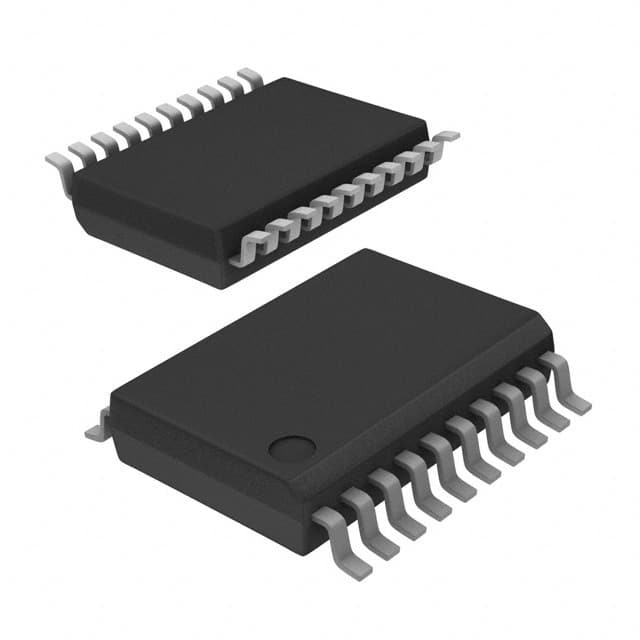Xem thông số kỹ thuật để biết chi tiết sản phẩm.

PIC16C717T-E/SS
Product Overview
- Category: Microcontroller
- Use: Embedded systems, control applications
- Characteristics:
- Low power consumption
- High performance
- Small form factor
- Wide operating voltage range
- Package: SSOP (Shrink Small Outline Package)
- Essence: A microcontroller designed for embedded control applications with low power requirements.
Packaging and Quantity
The PIC16C717T-E/SS is typically packaged in reels or tubes. The quantity per package varies depending on the manufacturer and distributor. It is commonly available in quantities of 100 to 1000 units per package.
Specifications
- Architecture: 8-bit
- CPU Speed: Up to 20 MHz
- Program Memory Size: 7 KB
- RAM Size: 368 bytes
- Number of I/O Pins: 18
- ADC Channels: 5
- Timers: 2
- Communication Interfaces: SPI, I2C, USART
Detailed Pin Configuration
The PIC16C717T-E/SS has a total of 18 pins. The pin configuration is as follows:
- VDD - Power supply voltage
- RA0/AN0 - Analog input / Digital I/O
- RA1/AN1 - Analog input / Digital I/O
- RA2/AN2 - Analog input / Digital I/O
- RA3/AN3 - Analog input / Digital I/O
- RA4/T0CKI/C1OUT - Timer0 clock input / Digital I/O / Comparator output
- RA5/AN4/SS/HLVDIN - Analog input / Slave select for SPI / High/Low Voltage Detect input
- RE0/RD/AN5 - Reset input / Read/Write control / Analog input
- RE1/WR/AN6 - Write control / Read/Write control / Analog input
- RE2/CS/AN7 - Chip select for SPI / Read/Write control / Analog input
- VSS - Ground
- OSC1/CLKIN - Oscillator input
- OSC2/CLKOUT - Oscillator output
- RC0/T1OSO/T1CKI - Timer1 oscillator output / Timer1 clock input
- RC1/T1OSI/CCP2 - Timer1 oscillator input / Capture/Compare/PWM 2
- RC2/CCP1 - Capture/Compare/PWM 1
- RC3/SCK/SCL - Serial Clock for SPI/I2C
- RC4/SDI/SDA - Serial Data In for SPI/I2C
Functional Features
- Low power consumption: The PIC16C717T-E/SS is designed to operate efficiently with minimal power requirements, making it suitable for battery-powered applications.
- High performance: With a CPU speed of up to 20 MHz, this microcontroller offers fast and responsive operation.
- Small form factor: The SSOP package allows for compact designs, making it ideal for space-constrained applications.
- Wide operating voltage range: The microcontroller can operate within a wide voltage range, providing flexibility in various power supply configurations.
Advantages and Disadvantages
Advantages
- Low power consumption enables longer battery life.
- High-performance capabilities allow for efficient execution of control algorithms.
- Small form factor facilitates integration into compact designs.
- Wide operating voltage range provides flexibility in power supply options.
Disadvantages
- Limited program memory size may restrict the complexity of applications.
- Limited RAM size may impose constraints on data storage and manipulation.
- Limited number of I/O pins may limit the connectivity options for peripheral devices.
Working Principles
The PIC16C717T-E/SS operates based on the Harvard architecture, which separates program memory and data memory. It executes instructions fetched from program memory and manipulates data stored in RAM. The microcontroller follows a Von Neumann model, where program instructions and data are stored in separate memory spaces.
The CPU fetches instructions from program memory, decodes them, and executes the corresponding operations. It interacts with peripheral devices through I/O pins, enabling communication and control of external components. The microcontroller's working principles rely on the execution of instructions and the manipulation of data to perform desired tasks.
Detailed Application Field Plans
The PIC16C717T-E/SS is suitable for various embedded control applications, including but not limited to:
- Home automation systems: Controlling lights, temperature, and security systems.
- Industrial automation: Monitoring and controlling machinery and processes.
- Automotive electronics: Managing vehicle subsystems such as engine control and infotainment systems.
- Consumer electronics: Power management, user interface control, and sensor integration in electronic devices.
- Medical devices: Monitoring vital signs, controlling drug delivery systems,
Liệt kê 10 câu hỏi và câu trả lời thường gặp liên quan đến ứng dụng PIC16C717T-E/SS trong giải pháp kỹ thuật
What is the operating voltage range of PIC16C717T-E/SS?
- The operating voltage range of PIC16C717T-E/SS is 2.5V to 5.5V.What are the key features of PIC16C717T-E/SS?
- Some key features of PIC16C717T-E/SS include 14-bit core, 8 MHz internal oscillator, and 5 I/O pins.Can PIC16C717T-E/SS be used in battery-powered applications?
- Yes, PIC16C717T-E/SS's low operating voltage range makes it suitable for battery-powered applications.What programming language can be used to program PIC16C717T-E/SS?
- PIC16C717T-E/SS can be programmed using assembly language or high-level languages like C.Is PIC16C717T-E/SS suitable for motor control applications?
- Yes, PIC16C717T-E/SS can be used for simple motor control applications due to its I/O capabilities.Does PIC16C717T-E/SS have built-in communication interfaces?
- No, PIC16C717T-E/SS does not have built-in communication interfaces, but it can be interfaced with external communication modules.What is the maximum clock frequency supported by PIC16C717T-E/SS?
- PIC16C717T-E/SS supports a maximum clock frequency of 8 MHz.Can PIC16C717T-E/SS be used in temperature sensing applications?
- Yes, PIC16C717T-E/SS can be used in temperature sensing applications with the appropriate sensor interface.Are there any development tools available for PIC16C717T-E/SS?
- Yes, there are development tools such as compilers, simulators, and programmers available for PIC16C717T-E/SS.What is the typical power consumption of PIC16C717T-E/SS in active mode?
- The typical power consumption of PIC16C717T-E/SS in active mode is around 5 mA at 5V.

